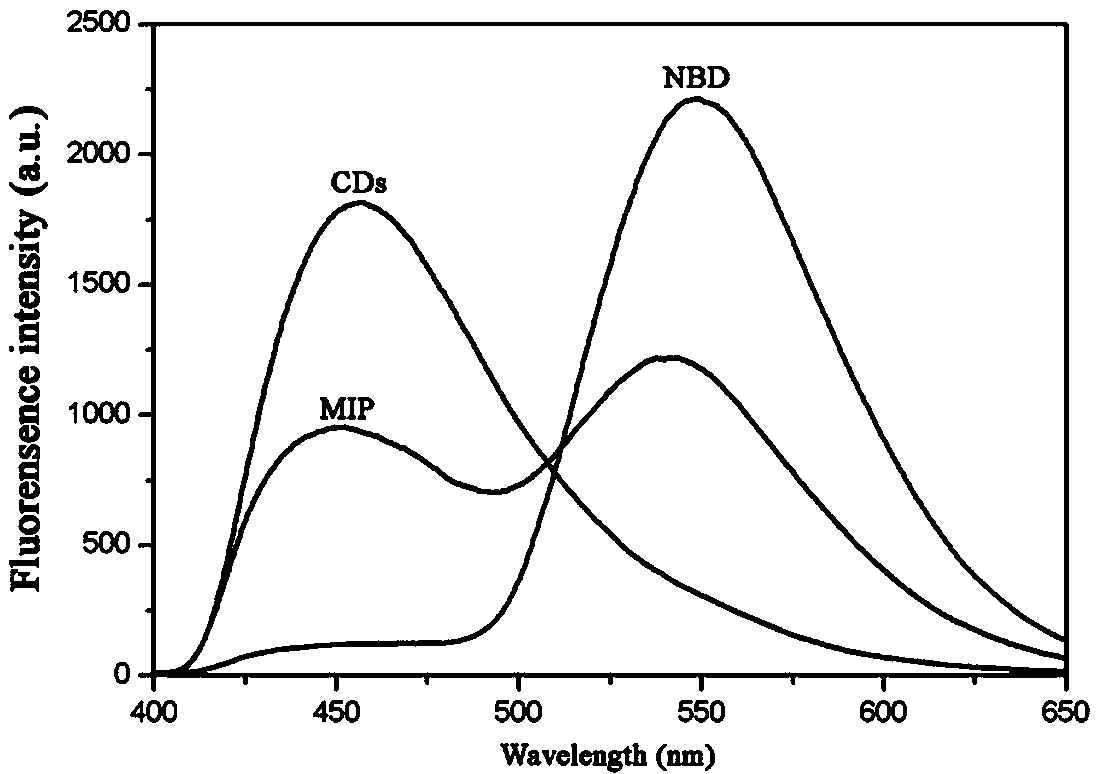Ratiometric fluorescent molecularly imprinted polymer and preparation method and application thereof
A technology of molecular imprinting and ratiometric fluorescence, applied in fluorescence/phosphorescence, chemical instruments and methods, material analysis by optical means, etc., to achieve the effects of process stability, high affinity and selectivity, and low energy consumption
- Summary
- Abstract
- Description
- Claims
- Application Information
AI Technical Summary
Problems solved by technology
Method used
Image
Examples
Embodiment 1
[0014] (1). Preparation of aminated silica: Add 15 mL ammonia water to 250 mL absolute ethanol, stir well at room temperature, add 2.5 mL TEOS after 30 min, react for 12 h, then add 1.25 mL TEOS and 0.1 mL APTES. After 12 h, the product was separated by centrifugation, washed with ethanol and deionized water until neutral, and then dispersed into 10 mL of ultrapure water to obtain solution A, which was stored at 4 °C.
[0015] (2). Preparation of APTES-modified CDs: Add 0.4 g of sodium citrate into 8 mL of ultrapure water and stir to dissolve, then add 1.5 mL of APTES, transfer to a reaction kettle at 200 °C for 2 h. The reaction solution was dialyzed with a 500 KDa dialysis bag for 12 h, and blown to 5 mL with a nitrogen blower to obtain APTES-CDs, which were stored at 4 °C in the dark.
[0016] (3). Preparation of APTES-modified NBD: Take a clean and dry two-necked flask, put it in a drying tube, and wrap it in tin foil. Under the condition of avoiding light, take 11.8 mg N...
Embodiment 2
[0019] (1). Preparation of aminated silica: Add 15 mL ammonia water to 250 mL absolute ethanol, stir well at room temperature, add 2.5 mL TEOS after 30 min, react for 12 h, then add 1.25 mL TEOS and 0.1 mL APTES. After 12 h, the product was separated by centrifugation, washed with ethanol and deionized water until neutral, and then dispersed into 10 mL of ultrapure water to obtain solution A, which was stored at 4 °C.
[0020] (2). Preparation of APTES-modified CDs: Add 0.4 g of sodium citrate into 8 mL of ultrapure water and stir to dissolve, then add 2.4 mL of APTES, transfer to a reaction kettle at 200 °C for 2 h. The reaction solution was dialyzed with a 500 KDa dialysis bag for 12 h, and blown to 5 mL with a nitrogen blower to obtain APTES-CDs, which were stored at 4 °C in the dark.
[0021](3). Preparation of APTES-modified NBD: Take a clean and dry two-necked flask, put it in a drying tube, and wrap it in tin foil. Under the condition of avoiding light, take 11.8 mg NB...
Embodiment 3
[0024] (1). Preparation of aminated silica: Add 15 mL ammonia water to 250 mL absolute ethanol, stir well at room temperature, add 2.5 mL TEOS after 30 min, react for 12 h, then add 1.25 mL TEOS and 0.1 mL APTES. After 12 h, the product was separated by centrifugation, washed with ethanol and deionized water until neutral, and then dispersed into 10 mL of ultrapure water to obtain solution A, which was stored at 4 °C.
[0025] (2). Preparation of APTES-modified CDs: Add 0.4 g of sodium citrate into 8 mL of ultrapure water and stir to dissolve, then add 2 mL of APTES, transfer to a reaction kettle at 200 °C for 2 h. The reaction solution was dialyzed with a 500 KDa dialysis bag for 12 h, and blown to 5 mL with a nitrogen blower to obtain APTES-CDs, which were stored at 4 °C in the dark.
[0026] (3). Preparation of APTES-modified NBD: Take a clean and dry two-necked flask, put it in a drying tube, and wrap it in tin foil. Under the condition of avoiding light, take 11.8 mg NBD...
PUM
 Login to view more
Login to view more Abstract
Description
Claims
Application Information
 Login to view more
Login to view more - R&D Engineer
- R&D Manager
- IP Professional
- Industry Leading Data Capabilities
- Powerful AI technology
- Patent DNA Extraction
Browse by: Latest US Patents, China's latest patents, Technical Efficacy Thesaurus, Application Domain, Technology Topic.
© 2024 PatSnap. All rights reserved.Legal|Privacy policy|Modern Slavery Act Transparency Statement|Sitemap


